“It’s one of the most far-reaching efforts in the nation for a major research university to make a total transformation of a complete campus energy system”, said Joe Stagner, a civil engineer who directs Stanford’s Department of Sustainability and Energy Management.
Despite the steep price tag, the university estimates that by going greener it will save be saving lots of green – $639 million by 2050 through lower utility bills and operating costs.
Under the plan, which received preliminary approval by the Stanford Board of Trustees last fall, the energy savings are expected to build up with time. By 2050, the campus is projected to emit only 50 percent of the greenhouse gases it emitted in 1990.
“And that’s a minimum, it doesn’t mean that we’re going to stop at 50 percent”, said Fahmida Ahmed, manager of sustainability programs at Stanford. She and Stagner wrote the new energy and climate plan that serves as the university’s sustainability roadmap and presented it to the Trustees in October 2009.
Although Stanford has pursued recycling, composting and energy efficiency since the 1980s, until just a few years ago, it lacked a single, cohesive campaign to shrink the university’s carbon footprint – a task made more urgent by Stanford’s steady growth spurts. By 2025, two million square feet of new academic buildings and housing are expected to be built for 2,400 additional faculty, staff and students.
“The whole idea to attack greenhouse gases gained momentum in 2006 and 2007,” said Stagner. “University stakeholders, including faculty from the Woods Institute to members of Students for a Sustainable Stanford and faculty and even some alumni, all of them let the university’s leadership know that they wanted Stanford to be more sustainable”, he added.
On average, the campus generates 262,000 metric tons – nearly 580 million pounds – of carbon dioxide and other greenhouse gases each year through direct sources such as generating electricity each day at an aging campus power plant, and indirect sources such as airline trips and commuting miles driven by faculty and staff. If no new initiatives are undertaken, pursuing instead a “business-as-usual” level of energy consumption and energy generation, Stanford is expected to produce 325,000 metric tons of greenhouse gases by 2020 and nearly 400,000 metric tons by 2050.
Stagner and his team realized early on that energy conservation improvements alone could not achieve substantial greenhouse gas reductions for a campus growing at such a fast clip.
“We had to come up with a comprehensive energy model that includes energy demand on one side and energy supply on the other side to inform how to best prioritize our work, to see what had the best return, environmentally, and the best bang for our buck”, said Stagner.
The biggest environmental gains, his team discovered, would come from overhauling the campus’ natural gas-fired power plant which has operated for more than 20 years and accounts for nearly 90 percent of the campus’ greenhouse gas emissions.
Since Stanford is situated in a Mediterranean climate, many of its buildings need simultaneous cooling and heating. Currently, the cooling system pipes chilled water into buildings to cool them and also remove excess heat that builds up inside them. As the water extracts the unwanted heat from buildings, it warms and is piped back to the central energy facility where massive cooling towers exhaust the excess heat from the water into the atmosphere. The loop continues, with the water being re-chilled at the central energy facility and sent back out to the buildings.
Conversely, heat and hot water are supplied to buildings in a separate loop. It uses steam, which is made as a byproduct of burning natural gas to generate electricity to power the buildings. The steam cools into hot water after it has been sent to the buildings, and then it is sent back to the central energy facility, where it is reheated and sent back out.
In October 2008, during a year-long audit of the campus’ hour-by-hour energy use, Stagner experienced an ‘a-ha moment.’
“I took a look at the data and saw that the potential for reusing the waste heat to heat the campus was much larger than we had hoped for and got very excited about the possibilities,” said Stagner.
Stagner realized that nearly half of the campus’ heating needs can be met through bypassing the cooling towers and reusing most of the heat which would otherwise be exhausted into the air. This new scheme of heat recovery is being called “regeneration.” Through it, the campus will also cut its water use by nearly 20 percent since less water would be used by the cooling towers.
The project won’t happen overnight, however. It will take five to 10 years, and university crews will have to dig up 10 miles of underground pipes that are currently designed to distribute steam – not hot water — to buildings.
When all of that is finished, the campus will be able to burn less natural gas to make electricity and will instead be able to buy electricity from utilities or from direct suppliers using renewables like solar and wind to green up the grid.
The electricity will power up to five new multimillion-dollar “heat recovery chillers.” The machines will form the backbone of the new energy loop, where warm water that would have been sent to the cooling towers instead will now be sent for further reheating and piped back out as 170-degree water to provide heat and hot water to buildings.
By the end of this year, Stagner will present to Stanford’s trustees an update of the heat recovery system and the broader energy and climate plan, which is receiving one last peer review to see if further greenhouse gas reductions are possible under it. But he and his team are already moving forward.
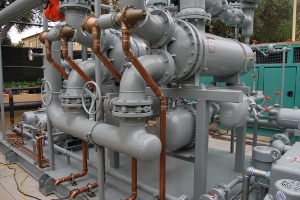 Stanford’s new heat exchange unit. Photo by Sheraz Sadiq
Stanford’s new heat exchange unit. Photo by Sheraz Sadiq
 Campus map showing the buildings where pipes carrying steam will need to be replaced by pipes carrying hot water. Photo and image copyright Stanford University
Campus map showing the buildings where pipes carrying steam will need to be replaced by pipes carrying hot water. Photo and image copyright Stanford University
On a patch of land behind Memorial Auditorium, for the past six months, workers have been installing a $750,000 heat exchange station next to Stanford’s new business school, the Knight Management Center, which will open later this year. The station is needed to convert the steam currently made by the campus power plant to hot water, which will then be distributed through new pipes snaking underground that will serve 12 new and existing buildings when it fires up next summer.
Other universities, including the University of Rochester in New York and Auburn University in Alabama, also have converted from steam to hot water to meet their heating needs, but not to the extent Stanford plans.
In addition to the engineering plans, Stanford also is working to change the behavior of its students, professors and staff.
“We live in an eco-minded area,” said Ahmed, whose office worked with students to create a guide to sustainable living that describes how to reduce water and electricity use and act sustainably beyond the dorms and dining halls. “But for conservation to be a part of daily experience there needs to be incentives that we relate to and feel encouraged about.”
One Stanford program, for example, establishes an annual baseline of average kilowatt-hours used for an individual school or administrative unit based on past consumption trends. Then, it allows that school or unit to keep whatever money is saved if it falls under its budget for energy spending. In three years, the program yielded a three percent decrease in energy use and $830,000 for the energy-saving participants.
Last year, a penalty component was added, so now departments that go over their budgets are supposed to pay back to the university the cost of excess electricity they used. The Office of Sustainability wouldn’t reveal which departments were penalized, pointing out instead that “there are sometimes valid reasons for their energy usage going up” and that the budgets for electricity use “can and will be revised over time as a trend appears.”
“If an academic department isn’t responsible for its energy expenditures or budget, it is in the same position as a renter in an apartment who isn’t responsible for paying for the utilities. The renter has no incentive for energy efficiency or water efficiency. It’s just human nature,” said Stanley Young, a spokesman for the California Air Resources Board, in Sacramento.
Stanford junior Ishan Nath wrote an editorial last fall in The Stanford Daily, calling for an expansion of the incentive program so students could pocket some of the cost savings from lower energy use in their dorms.
“It seems that the double benefit of reducing greenhouse gas emissions while saving money is something we should be taking advantage of in any place we can and I think it’s really important that Stanford is leading in this direction,” he said.
Another key part of the Stanford plan to reduce greenhouse emissions is to retrofit existing buildings.
There are nearly 200 buildings on campus that are larger than 20,000 square feet, roughly the size of a small supermarket. A 2004 study found that 12 buildings accounted for 33% of the campus’ electricity use.
“We put together a new program to look at a single building in detail and go top to bottom and find energy savings opportunities,” said Scott Gould, a senior energy engineer with the Department of Sustainability and Energy Management who oversees the Whole Building Retrofit Program.
In 2007, the campus approved $15 million in funding to retrofit these energy-intensive buildings, many of which contain research labs built in the 1960s, ‘70s and ‘80s. Some have annual energy bills of $2 million to $3 million each.
Two building retrofits are currently taking place, one at Gilbert Hall, which houses the biology department, and the other at the Beckman Center for Molecular and Genetic Medicine. The fume hoods in them are being fitted with valves that can more efficiently regulate the flow and exhaust of air, so that instead of 10 air exchanges in an hour, there may only be six or eight. New valves also will control the total amount of air supplied to a room.
“It’s a technology that wasn’t available in the ‘70s”, said Gould, whose job is compounded by the fact that the retrofit work needs to typically take place over short periods of time to minimize the impact to the still-active labs.
It’s easier to design super-energy efficient buildings from the start than going back and retrofitting old ones.
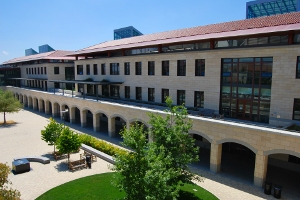 A view of the Y2E2 building. Photo by Sheraz Sadiq
A view of the Y2E2 building. Photo by Sheraz Sadiq
The greenest building on Stanford’s campus – and a model for future construction – is the Jerry Yang and Akiko Yamazaki Energy + Environment Building, known as “Y2E2.” Opened in 2008, the four-story, L-shaped building uses 38 percent less energy and 90 percent less total water than older buildings – the latter feat accomplished in part by using recycled water for flushing toilets and rainwater for irrigating landscaping. Four atriums funnel natural light through angled skylights, and they also serve as the building’s lungs, drawing in fresh air and circulating heated air through vents that open and close automatically throughout the day.
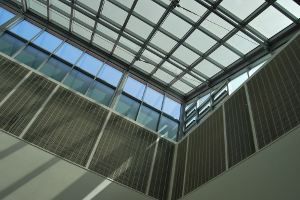 A skylight inside the Y2E2 building. Photo by Sheraz Sadiq
A skylight inside the Y2E2 building. Photo by Sheraz Sadiq
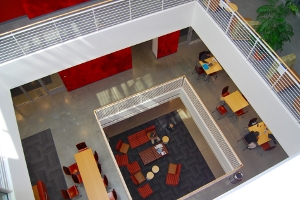 Looking down the atrium inside the Y2E2 building. Photo by Sheraz Sadiq
Looking down the atrium inside the Y2E2 building. Photo by Sheraz Sadiq
Stanford also has solar power demonstration projects at seven locations on campus but they generate enough power currently to meet only two percent of the campus’ energy needs. Ahmed acknowledged that solar power has the potential to meet 10 percent of the sunny campus’ energy needs, but the university is continuing to track progress on solar power technology before committing to its wider use on campus.
So far, students seem pleased with the university’s level of planning and implementation around sustainability.
“It’s a period of tremendous uncertainty in what’s going to happen with California’s climate policy,” said Nath. “Without knowing that, it’s impossible to fairly plan for what type of renewable energy to use, and it’s difficult to compare the financing to see what’s the best decision.”
John Ten Hoeve is president of the Stanford Solar and Wind Energy Project, a group run mostly by graduate students trying to promote renewable energy at Stanford. “I believe I speak for the group when I say that we are very pleased with the new climate and energy plan”, Ten Hoeve said, while complimenting its Office of Sustainability for being “open-minded” to opportunities to cut Stanford’s carbon load.
Stanford’s plan focuses on more near-term energy supply and conservation steps to curb campus emissions, but doesn’t fund much renewable energy at the moment. A chart laying out the expected emissions savings as color-coded wedges from building retrofits, heat recovery and other initiatives, has a wedge that corresponds to emissions savings through electricity generated by renewable means, like solar, wind and geothermal power.
Ten Hoeve pointed out that the ‘green electricity’ wedge doesn’t kick in fully, however, until 2035. “If Stanford were to produce its own renewable energy, through a few well-sited local wind turbines for example, it would be great PR for the university at little to no cost, which is why we hope it will happen sooner than later”, he said.
Some students think that an array of solar panels, such as the one adorning the Y2E2 building, do more than just green the grid.
“It’s important to have them in places where people can see them and when they come to Stanford, they’ll say, ‘oh, maybe solar panels are developing enough to be used on a wide scale’”, said Nath.
Junior Eli Pollak, a member of Students for a Sustainable Stanford, said he’s impressed by the Stanford plan, but would have liked to have seen more students involved in drafting it.
“In keeping with Stanford’s educational mission, it would have been beneficial for the administration to have drawn on the intellect of the students and the students could have gained real-world experience to address climate change and see how a large institution approaches climate change and energy planning,” Pollak said.
Stanford isn’t alone in trying to improve energy efficiency and reduce its carbon footprint.
The American College and University Presidents Climate Commitment has recruited nearly 700 college and university presidents to cut more than 30 million metric tons of greenhouse gas emissions annually across their campuses.
“The niche that we were filling was helping people learn from each other,” said Paul Rowland, executive director of the Association for the Advancement of Sustainability in Higher Education, an organization that has created a tool to help universities and colleges that have signed the climate commitment measure and report their annual greenhouse gas emissions.
The first university to have achieved carbon neutrality, Rowland said, is the College of the Atlantic in Bar Harbor, Maine, which it did in part by purchasing renewable energy credits to offset its greenhouse gas emissions.
Stanford has declined to join the organization ever since 2006 when it was first asked.
“Stanford commits to reductions it can meet. Committing to carbon neutrality without having the solutions at hand must have seemed not very authentic to the administration at the time,” said Ahmed.
Stanford’s energy and climate plan also does not endorse the use of carbon offsets or renewable energy credits, citing in part their “regulatory uncertainty,” which suggests the university is more focused on projects campus officials can directly observe, control and monitor to track the progress on its emissions reductions.
The chancellors of the 10 campuses that make up the University of California system have, however, signed onto the ACUPCC. The UC campuses have set a goal of reducing greenhouse gas emissions to 2000 levels by 2014 and to 1990 levels by 2020, while also eliminating all waste sent to landfills by 2020. After these targets have been met, the UC sustainability policy directs the campuses to pursue carbon neutrality “as soon as possible.”
“Over the past five years, the UC system has saved $15 million by replacing aging lighting, heating and ventilation systems and expanding the monitoring and metering of campus buildings,” said Matthew St. Clair, director of the UC sustainability efforts.
At UC Berkeley, energy efficiency projects such as changing leaky heating and cooling systems and installing more efficient lighting in its buildings, some of which are more than 100 years old, has cut the campus’ electricity use. At Tang Center, home to the university’s health services, an analysis revealed that the air circulation system was running 24 hours a day. So a new air circulation system was installed, saving the university each year enough electricity to power 46 single family homes.
UC campuses are also exploring projects that will generate a total of 10 megawatts of on-site renewable energy by 2014. To date, three of them – Irvine, Merced and San Diego – have one-megawatt solar panel arrays installed at each of their campuses. The solar array at Merced spans nearly nine acres and provides the campus with nearly 20 percent of its annual energy needs.
“As a public institution that includes a mission of public service, we need to demonstrate to the taxpayers and voters of California that we are being good citizens in reducing our environmental impact, cutting costs through efficient resource consumption and modeling sustainability leadership”, said St. Clair.
Stanford’s Stagner said he similarly feels that colleges and universities don’t need to wait for a blueprint from the government to start tackling climate change, adding that they have a responsibility to “to help create the scientific, human, cultural, and political solutions to it, and to educate tomorrow’s leaders so that they may continue to work on this challenge and advance civilization toward a sustainable future.”
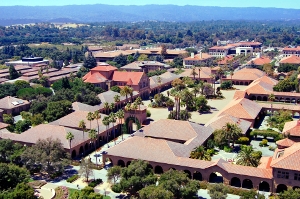 A view of Stanford’s campus, taken from Hoover Tower. Photo by Sheraz Sadiq
A view of Stanford’s campus, taken from Hoover Tower. Photo by Sheraz Sadiq




